This CE Center article is no longer eligible for receiving credits.
View course on architecturalrecord.com »
In cities across the country, a profusion of construction cranes points to a bustling building climate, which should make architects happy. Not so fast. Despite a sound economy, architecture is facing a reckoning. This special section examines firms of varying sizes and the challenges—and opportunities—they face today, with greater competition and client expectations, as well as an outmoded business model and the urgent need to evolve along with technology.

PHOTOGRAPHY: COURTESY GENSLER
Gensler's Los Angeles Office
Small Firms
Practitioners in six studios talk about being hands-on, resourceful, and nimble in order to stay competitive in a fast-evolving field.
By Deborah Snoonian Glenn
Close relationships with clients, value-added service, an emphasis on design quality, a collegial work atmosphere—the appeals of small firms have lured many architects into opening up shop. But once you’ve been in business for a while, what does it really feel like? When asked about how the Philadelphia firm Digsau establishes fees for clients, a tongue-in-cheek response from one of its four cofounders, Jeff Goldstein, captures the flavor of having a small architecture firm today. “We do our best, based on what we’ve learned from past projects,” he says. “Sometimes we get it right, and we’re glad when that happens. But if any of the other firms you’re talking to have cracked the code on this, let me know.”
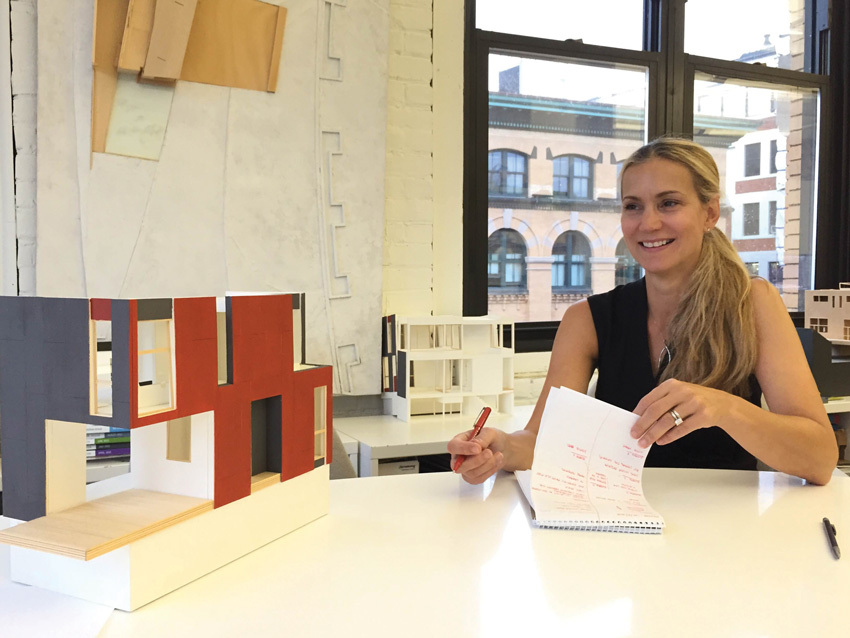
PHOTOGRAPHY: COURTESY MERGE ARCHITECTS
Elizabeth Whittaker of Merge Architects in Boston
Conversations with principals from six firms across the country, ranging in size from two to just over 20 employees, revealed uncertainties about how to juggle projects and finances while striving to bring in new, meaningful work. But the unease is tempered by satisfaction with their projects, and a deep commitment to good design and its power to transform lives.
Small architectural firms have always dominated the profession. According to the AIA’s 2016 Firm Survey Report, 77.3 percent of firms have nine or fewer employees, representing roughly one-fifth of all architects and bringing in 15.4 percent of all architectural billings. For firms of 10 to 49 people (17.6 percent of all practices), the figures are 32.3 percent and 33.3 percent respectively. Though the stats on small businesses of all types are sobering—half of them fail after five years, and 70 percent are kaput by year 10—all six of the firms who spoke to RECORD have stuck it out for eight years or longer, and five weathered the Great Recession. So what helped these firms stay in business? And will the circumstances that boosted them in the past continue to do so in the future?
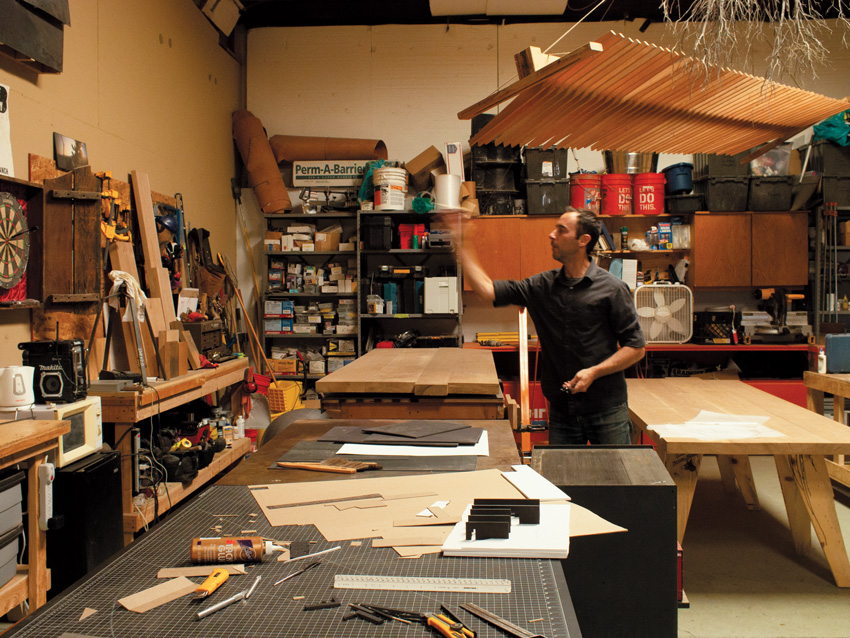
PHOTOGRAPHY: COURTESY DUST
Cade Manning Hayes of DUST, in Tucson, Arizona
For Digsau and others, engaging in diverse project types kept them afloat during lean times (they launched in pre-recession 2007). “We always wanted to be working in different building sectors,” says Goldstein, “so we weren’t overly vulnerable in any one area when the recession hit, and we’d hope the same would be true in future downturns.”
So what is it that prompts these designers to take a chance and hang out their shingle in the first place? Personal connections are often one factor. Family and friends of employees gave Elizabeth Whittaker’s Boston practice Merge Architects its first townhouse renovations and small retail spaces and cafés when Whittaker opened its doors in 2003. “Through word of mouth, we earned a reputation for delivering high design quality on ridiculously tight budgets, and for using materials in a resourceful, creative way,” she says. Her project mix now includes multifamily housing, large corporate interiors, and university buildings.
Some firms picked up momentum after winning awards or securing a high-profile project. Merge was named a RECORD Design Vanguard in 2014, and then Whittaker herself won a 2015 Emerging Voices award from the Architectural League of New York; she says “things definitely ticked up” afterward. The New York firm nARCHITECTS, also a Design Vanguard—in 2004—had a surge after winning the prestigious Young Architects Program competition the same year to design a seasonal installation at MOMA/PS1, an arts space in Queens. Their project, a bamboo canopy, “became a gateway to many things we’re doing now, like Pierscape, our renovation of the old Navy Pier in Chicago with James Corner Field Operations,” says Eric Bunge, firm principal and cofounder with wife and partner Mimi Hoang.
Engaging with community organizations has helped Jensen Architects in San Francisco land such high-profile clients as SFMOMA, for whom they designed a rooftop sculpture garden, and IDEO, which tapped the firm to overhaul its San Francisco offices. Founder Mark Jensen has served on many arts boards and commissions in the Bay Area, as have several of his colleagues. “Our interests as architects led us to participate in these efforts, which enabled us to meet wonderful clients who value design as much as we do,” he says. He and others in the firm also teach at California College of the Arts (CCA), a common way that small-firm practitioners supplement their incomes while expanding their horizons.
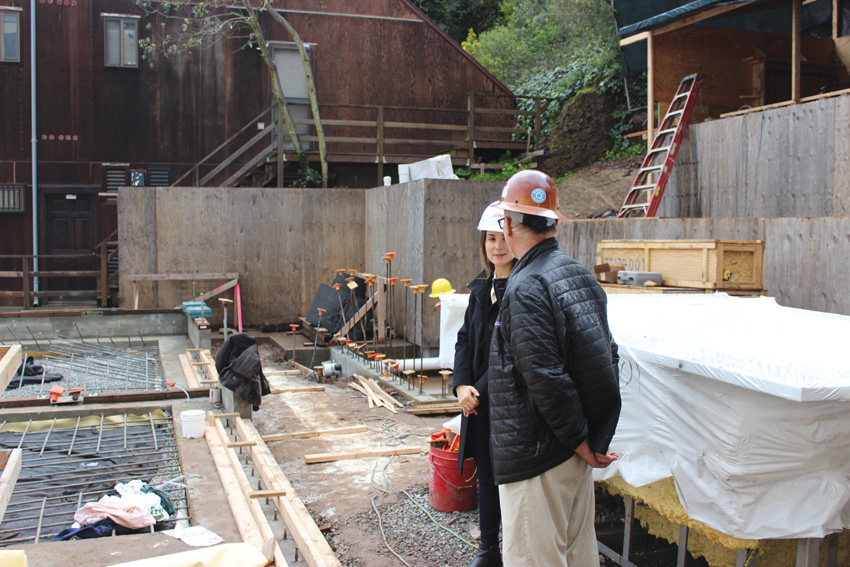
PHOTOGRAPHY: COURTESY JENSEN ARCHITECTS
Jensen Architects on-site in San Francisco
For the Chicago firm JGMA (Juan Gabriel Moreno Architects), focusing on a particular client base—underserved communities—led to opportunities outside that realm. “There is such a thirst for high-quality architecture in low-income neighborhoods, and it can lift them up,” says its founder, Juan Gabriel Moreno. After building a new athletic field for Uno Soccer Academy, a high school in a largely Latin neighborhood in southwest Chicago, he got a call from local developer John Buck, who’d been following the project. “Have you ever done a high-rise before?” Buck asked. Moreno told him no. “Good,” Buck said. “I’m going to give you your first one.” Moreno ended up working on schematic design and interiors for Buck’s residential building at 311 Illinois in the River North neighborhood, near the Magnificent Mile.
“We can’t always compete on a fee basis with larger firms, but we feel we can deliver a higher level of design and hands-on service,” says Digsau’s Jeff Goldstein.
At the extreme end of small, the two-person firm DUST in Tuscon enjoys the freedom to run a practice driven by the master-builder concept. Started by former Texas Tech architecture classmates Cade Manning Hayes and Jesús Edmundo Robles, Jr., the firm has built everything they’ve designed, working closely with local artisans, designers, and craftspeople. The firm’s website showcases just three finished projects—two passive houses and an outdoor pavilion, all in Arizona—along with smaller-scale work such as furniture and public art. “We see ourselves as an arts-driven practice, and we really don’t think about ‘putting business first,’ so to speak,” says Robles. “If we grow at all, we’d want to do it organically, according to where the work takes us.”

PHOTOGRAPHY: COURTESY nARCHITECTS (LEFT); DIGSAU, ©HALKIN MASON PHOTOGRAPHY (RIGHT)
nArchitects in New York (left), Digsau in Philadelphia (right)
All the firms expressed a similar idea of what they hoped would sustain them: projects that are ambitious in scope and program, and make a positive impact on their occupants and community, with clients who value what the architects bring to the table. “We can’t always compete on a fee basis with larger firms,” says Goldstein, “but we feel we can deliver a higher level of design and hands-on service.” He points to the firm’s new residential hall for Swarthmore College—a cluster of three slate-clad volumes—as a sort of platonic ideal: done for a repeat client who emphasizes sustainability, the project approaches net zero energy use and successfully mediates an important junction near the campus baseball field and a group of historical buildings. “These are the sorts of projects—and clients—you dream about,” he says.
That said, he and his cohorts know that clients typically tap larger firms for larger projects. Yet small firms are hesitant about the trade-offs of growing bigger and ceding control. “Most of our work is local, and we prefer it that way,” says Jensen. “Our leadership is deeply involved in every project. We’re a very hands-on practice; for a long time, we had just nine or 10 employees. Now we’re at 24 people because of our workload, and I feel as if that’s our fighting weight.” Goldstein believes there’s potential in teaming up with a firm of a similar size and complementary skill sets to pursue projects that larger firms typically win. “Convincing clients it’s cost-effective might be a tough sell, but I’d like to try it out,” he says.
There’s no question that today’s business climate for small firms is far more complex and challenging than in years past. “I’m bracing myself for the next recession,” Whittaker admits. “Housing will take a hit first, and that represents a big chunk of what we’re doing. Even though we’re busy, it all feels extremely fragile.” Jensen says technological innovations have caused a major shift in client expectations. “Tools for drawing, modeling, and communication have proliferated and improved, so clients expect the same level of service from firms of any size,” he says. “That means we have to invest in technology on a regular basis just to remain competitive.”
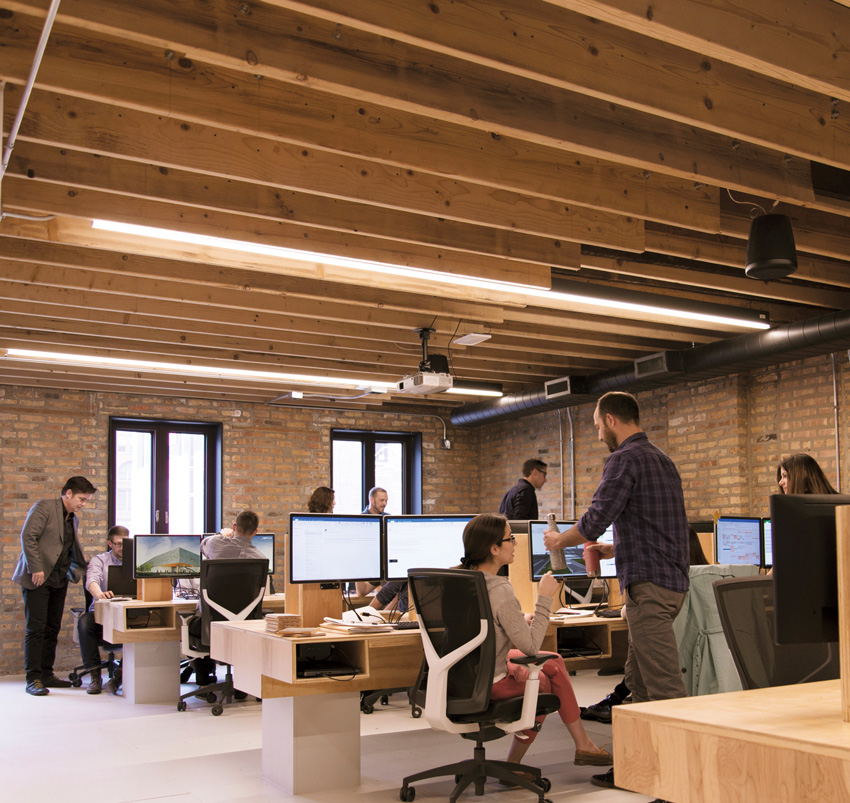
PHOTOGRAPHY: COURTESY JGMA
JGMA (Juan Gabriel Moreno Architects) in Chicago
And money remains a big problem. “Collecting fees has gotten tougher and tougher,” says Moreno. “It’s hard, especially as a young firm, to get enough revolving credit to keep bills paid. Architects have somehow become the bankers for projects. We do all the work in advance, incur expenses of our own, and then need to chase down checks once it’s over. It’s not how I want to be spending my time.” These firms also do too much work for too little money. “Conceptual designs were not a separate deliverable when we started our firm,” says Bunge. “Now we do them for every project and fees don’t accurately reflect the extra work.” Whittaker is pushing back more often on scope creep with clients. “Early on, I lost my shirt on some projects,” she admits. “I can’t do that anymore.” Her fees typically range from 5.5 to 11 percent depending on the program and project type; they can go as high as 15 to 18 percent for smaller projects and residential work. Like people at many firms, she’s moved away from hourly billing toward a fixed-price-plus-expenses model. “With hourly billing, I found that clients would nickel-and-dime every invoice, because they’d question how long certain tasks should take,” she says. “It was exhausting.”
Though they know they can’t control the economy or where their next clients might come from, these designers also know architectural practice must continue to evolve to remain viable. Getting involved in projects at the earliest planning stages is a critical step. “It used to be that landscape architects got hired last on a project, and now they’re often hired first, because we’re paying more attention to how buildings and land use must work together,” says Jensen. “But if we’re brought on at the end and told ‘put your building here,’ that limits our effectiveness at coming up with creative ways to meet broader program goals.”
Maintaining racial and gender diversity on their staffs is also very much on their minds. “We should reflect the society we live in,” says Bunge. “We have to understand why these inequalities exist in our profession at large, and how they can be rectified.” He also believes engagement in progressive politics is an underappreciated opportunity for small firms, which often work locally and can be more agile than large ones. “The conversations around memorials and historical attractions are shifting to include people whose voices were once left out,” he says. The state of New York recently tapped nARCHITECTS to design the Equal Rights Heritage Center in Auburn, New York, where Harriet Tubman lived for the last 15 years of her life. Originally envisioned as a simple welcome center, the program has grown to encompass exhibitions about the Underground Railroad, abolition, women’s suffrage, and LGBTQ rights, touting the state’s and Auburn’s roles as leaders in the social-justice movement.
Perhaps the most important survival skill these small-firm leaders have to carry them into the future is a steadfast devotion to their calling, despite its many obstacles and unknowns. “Running a small firm has always been tough, and it’s true that today it’s tougher than ever and harder to know what’s around the corner,” says Jensen. “But we have a lot of great work with great clients who appreciate what we bring to them. And I’m still happy to come to work every day. As long as that’s true, I’ll keep on doing this.”
A former senior editor for both ARCHITECTURAL RECORD and This Old House, Deborah Snoonian Glenn lives in Los Angeles and writes about design and other topics.
DIGSAU
Philadelphia
Founded in 2007
17 Employees
DUST
Tucson, Arizona
Founded in 2007
2 Employees
JENSEN ARCHITECTS
San Francisco
Founded in 1994
24 Employees
JGMA
Chicaco and Medellín, Colombia
Founded in 2010
22 Employees
MERGE ARCHITECTS
Boston
Founded in 2003
16 Employees
nARCHITECTS
New York City
Founded in 1999
10 Employees
Medium Firms
Midsize, design-oriented firms straddle a fine line between smaller, scrappier studios and large corporate offices, often competing against both.
By Josephine Minutillo
It’s not always clear when to make a leap. “The hardest period for us was when the office had 25 people,” says Sara Lopergolo, a partner in the now 70-person New York–based firm Selldorf Architects, whose early work on art galleries and residences has led to larger museum projects and apartment towers. “That was the moment we realized we needed to put systems in place to grow, recognizing that we needed to hire for specific roles, upgrade technology, and reorganize the office structure to allow expansion.” Transitioning from a small studio to a midsize firm often entails an exponential increase in overhead—in some cases supporting multiple locations. But it also brings more opportunities, including projects that are larger and more complex, even global.
.jpg)
PHOTOGRAPHY: COURTESY DILLER SCOFIDIO + RENFRO (LEFT); © GEORDIE WOOD (RIGHT);
Diller Scofidio + Renfro’s New York office (left) and its partners (right, from left to right), Elizabeth Diller, Charles Renfro, Benjamin Gilmartin, and Ricardo Scofidio
A midsize firm is like the middle child, competing both with large corporate firms and the wealth of assets available to them, and small offices that can be nimble and may produce the same amount of work on a shoestring budget. In fact, midsize firms are hard to sustain: in recent years, more and more of them have been swallowed up by behemoths like Perkins + Will (which snapped up Texas-based interiors firm lauckgroup and the much larger Danish firm Schmidt Hammer Lassen just since the start of 2018). But despite the challenges, many principals will tell you that their “magic number” falls somewhere in that middle ground between 20 and 100 people, even though less than 10 percent of all American firms are that size. “Seventy feels like a good number for us,” says Annabelle Selldorf, founder of her eponymous firm. “The studio-like environment makes it possible for me to still be involved in all the projects with the four partners. And we can get the whole office together in the conference room. That might seem minor, but it is important in having a good spirit in the office, where people can really get to know one another.”
At 30 people, Los Angeles–based Michael Maltzan Architecture is working on residential, commercial, cultural, and institutional projects at various scales across the globe, but the founding principal feels that midsize crunch. “We compete against a very wide range of firms,” says Maltzan, noting that he’s been on short lists and walk-throughs with large corporate firms. “It’s surprising, because they come with a whole different culture and depth of resources,” he says, “and you’ll also see very small, emerging firms, at times.” That didn’t used to be the case, according to Maltzan, but it shifted significantly during the Great Recession. “You can’t put too bright a line under how much the recession—in sometimes very dramatic and sometimes subtle ways—changed the structure of the profession.”
The AIA’s 2016 Firm Survey Report says that, in terms of revenue, U.S. architecture firms made a nearly full recovery from the recession. But many architects say that fees have not rebounded to their pre-2008 levels and that clients increasingly expect more—and aren’t always willing to pay for it. “We never included designs for RFQs,” says Lopergolo, “but now many of them require it.” Joe Valerio of the 82-person Chicago-based firm Valerio Dewalt Train, which works frequently with the tech industry, points to other changes in the RFQ and interview process. “They not only want to know who on your staff will be working on a project and how many hours they will be spending on it, they want to see those people’s résumés.”
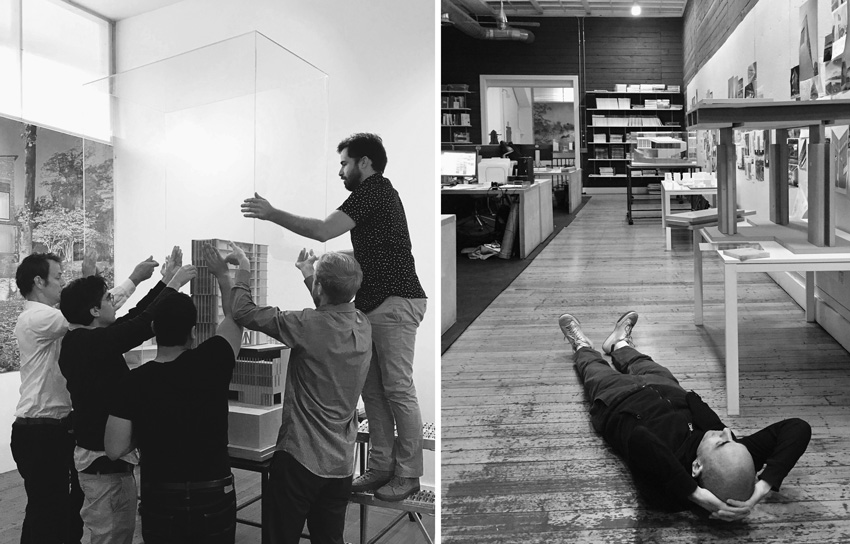
PHOTOGRAPHY: COURTESY NADAAA
NADAAA team members (left) and founder Nader Tehrani in the Boston office (right)
Competitions, on the other hand, have almost always been a losing financial proposition for firms, which can spend as much as 10 times what they receive as a fee (if there is one) for a short-listed competition, with only a small chance of winning. But when it works out, it can make all the difference. To weather the recession, Nader Tehrani took a gamble, entering his firm, then Office dA, in 14 competitions and RFQs in 2008, coming away with three wins—the Melbourne School of Design, the Hinman Building at Georgia Tech, and the Daniels Faculty at the University of Toronto—a trio of architecture schools his 25-person Boston-based firm NADAAA has recently completed.
Similarly, back in late 2009 and early 2010, when most studios were struggling to survive, New York–based Diller Scofidio + Renfro (DS+R)—an interdisciplinary practice that had only completed one major building, the Institute of Contemporary Art in Boston—won six competitions in a row, including the Broad Museum in Los Angeles, the Museum of Image and Sound in Rio de Janeiro, and the Vagelos Center at Columbia University in New York. In one year, the office grew from 40 to 80 people—it is now at about 100 and continues to enter many competitions. “Maybe we were just lucky, but I think there’s a double reason,” says DS+R partner Ben Gilmartin. “We’re a highly specialized practice. Our business model isn’t based on cranking out the same thing over and over again. It’s a model that is very hard to sustain today because so many things can be automated. Contractors can take over a lot of that work without even needing architects to participate.But in many other ways, there’s a shrinking of our market. Being in a space where you have the privilege to do pretty distinct, one-off projects that are highly creative, we’ve been able to increase our agency.” And their visibility.
Underscoring the value architects bring to a project has become ever more important, given tightening purse strings and evolving technologies. “I think the recession made everybody sit up and say, ‘What do we need to do to increase the value that we provide?’ ” says Valerio. “An architect always believes that, whatever the question is, design is the answer. But do we really understand the question?”
To succeed and thrive, architects are expanding their services, responding to the needs of clients to help solve complex problems. “We’re seeing large-scale developers turning toward architecture to help them work through the development business model,” says Maltzan, who from early in his career took up a community-liaison/developer role for many of the low-cost housing projects he’s completed. “Lately we’ve been asked to help developers plan the programming and start to strategize an approach to getting land entitlements. Architects are working more in the space of urban planning and urban design. There’s less of a distinction between architecture and landscape and planning than there might have been years ago.”
When it comes to complicated projects, architects are often the glue. “My biggest power is when I go into a meeting filled with consultants, engineers, planners, this and that, and everybody brings expertise to the table, none of whom can paint a picture that’s larger than the sum of what they know,” says Tehrani, who juggles his practice with his role as dean at the Cooper Union School of Architecture in New York. “As architects, we conceptualize something that is a bridge between them.”

PHOTOGRAPHY: COURTESY VALERIO DEWALT TRAIN
Joe Valerio of Valerio Dewalt Train in his Chicago office
Finding senior architects with that kind of expertise, however, is a common struggle for midsize firms: some left the profession after the recession; others are less willing today to risk a stable position at a large firm for a new, less certain one. “During the height of the last building boom, when people were doing really big projects, firms couldn’t hire fast enough,” explains Katherine Faulkner, a founding principal of NADAAA with Tehrani, who admits to turning down work rather than hiring too quickly. “That became a real problem, because there were very good people that you would bring in, but you just can’t expect them to know all your standards and how you work. Even a very senior person would need time to join in.” Though Faulkner has taken a slow approach to growth, she would eventually like to see the office reach 50.
For a variety of reasons, it can make sense for a small to midsize firm to partner with a larger one on a big project. “If you’re doing a performing-arts center, and there’s a firm that has done many of those, you stand to benefit so much from their intelligence,” says Tehrani. “We’re working with DLR right now. That collaboration is something that catapults you into the stratosphere.”
Though Maltzan’s firm will often be the design architect and architect of record, it too collaborates with bigger firms. “If we were doing full service on all the projects that we were doing, the office would probably be twice the size,” he admits. For instance, the firm just finished the Brickyard, a two-building office complex in Los Angeles for Tishman Speyer, and the executive architect was Gensler. “They have a long relationship with Tishman Speyer on commercial buildings, so that made a certain amount of sense.”
With the challenges for midsize firms come advantages, besides the obvious one of maintaining an intimate, or at least informal, office culture. “The office needs to be at this scale to legitimately take on larger, more public institutional projects,” says Maltzan, whose staff size rebounded to its pre-recession level in recent years. Those types of projects tend to be more profitable. Private residential work—the bread and butter of many smaller practices—can sometimes be a drain on resources. “If you’re designing a house, and you’re charging 20 percent, it’s probably not enough, because the clients will ask you for endless handholding, revisions, and oversight that will cost you 30 percent to do,” explains Tehrani. “If you’re doing a tower with repetitive units and relatively little variation, you stand to get a lot of profits just from the bulk, even if the stakes are bigger.”
When asked where they see architecture heading, these architects are both hopeful and cynical at the same time. “I think the future of the profession and the way that we practice is an enormous question mark,” says Maltzan. “But I don’t think the discipline of architecture has ever been more valuable than it is today. What architecture, in its broadest definition, can bring—the type of intelligence, of historical knowledge, of creative ability, and of critical thinking that the discipline has at its core—I think is more powerful than ever.” Despite economic and technological pressures, midsize, design-oriented firms like these believe they are uniquely positioned to translate this expanding influence of architecture into practice.
DILLER SCOFIDIO + RENFRO
New York
Founded in 1981
100 Employees
MICHAEL MALTZAN ARCHITECTURE
Los Angeles
Founded in 1995
30 Employees
NADAAA
Boston
Founded in 2011
25 Employees
SELLDORF ARCHITECTS
New York
Founded in 1988
70 Employees
VALERIO DEWALT TRAIN
Chicago + Other Locations
Founded in 1994
82 Employees
Large Firms
As technology streamlines the design and drawing-production process, large practices grapple with antiquated business models and fee structures.
By Martin C. Pedersen
In his 2005 book on globalization, Thomas Friedman famously declared the world flat. For many large firms, the author’s theory was already fact then, and it may be even more relevant now. Clients today have access to virtually any firm in the world; with the proper resources, any firm can work anywhere. As a result, the world feels undeniably small. “We all find that everybody is everywhere nowadays,” says Richard Olcott, a partner at Ennead, a 190-person firm with offices in New York and Shanghai. “You can be in Kansas somewhere, turn around, and Norman Foster is standing right behind you. Everywhere we go, we see a lot of the same faces.”

PHOTOGRAPHY: COURTESY MARMOL RADZINER
Marmol Radziner’s office in a former movie-production studio in West Los Angeles
For large firms (those with 100 to 600 employees), it’s a world of promise, opportunity, and uncertainty. A strong global economy and the ability to access it have been countered by fierce competition, low fees, and shifting business models, as the evolution of digital technology reshapes the entire profession. Firms with high head counts and deep pools of talent are ripe for creative reinvention, but vulnerable as well. “I’d put the 100-to-200-person firm in the high-risk category right now,” says Frank Stasiowski, president of PSMJ Resources, a management-consulting firm serving the architecture and engineering (A&E) industry. “We’re busier than ever with mergers and acquisitions in that range,” he says. “The big, publicly traded firms such as Stantec, AECOM, and Jacobs need access to design resources and markets, so they’re buying them, and they tell us they don’t want to talk to anybody less than 100 people.”
And digital technology, of course, keeps advancing. BIM has been revolutionary, but its current capabilities will look quaint in no time. The Virtual Reality goggles increasingly employed to dazzle clients may, before long, look like the clunky portable phones of the pre–Steve Jobs era (surely something seamless, immersive, and goggle-free awaits us in the not-so-distant future). “In terms of technology, we’re probably in the first inning of a 10-inning game,” as Stasiowski puts it.

PHOTOGRAPHY: COURTESY KPF
The KPF team on-site at the firm’s 10 Hudson Yards tower in New York
Still, BIM and rapidly improving simulation and visualization tools allow more design work to happen at the front end of projects, with multiple iterations and explorations the new norm. “We’re working on what will be the tallest office building in Austin [Texas] right now,” says Laurence Speck, a senior principal at Page, a 479-person A&E firm with six offices in the U.S. and one in Dubai, “and the clients—because we can show them—want to see every single corner of their building rendered.” These enhanced views, however, come with some risk. “Expectations get higher and higher,” Olcott says. “But you have to be really careful to make sure you get paid for that stuff.”
Getting fairly paid has never been easy. But two events in the recent past—one specific, the other ongoing—have placed even more financial pressure on firms of all sizes. The first was the Great Recession, which saw business crater, firms close, and fees drop precipitously. Sadly, the aftereffects of that upheaval are still being felt. “Fees really haven’t rebounded since the recession,” Speck says. “They’re still incredibly low and competitive, especially in market sectors like higher education.”

PHOTOGRAPHY: COURTESY KPF
KPF’s New York office, with a model of a tower in Seoul in the foreground
At the same time, the tech revolution’s efficiencies can be a double-edged sword: they miraculously streamline the process but have begun eroding one of the once-lucrative tasks of the architecture office: construction drawings (CDs). “The traditional models for how fees are generated don’t really correspond to the current processes,” says Brendan Connolly, a partner at Mithun, a 159-person firm with offices in Seattle and San Francisco. “With these BIM tools, there’s a much heavier front-end concentration of design time and think-ing, so we’re often in a pressured situation, early on, to get a lot done with less fee that we need to, quote unquote, ‘make up at the end.’”
Indeed, despite changes in the delivery process, many firms have not significantly altered their fee structures. “This industry hasn’t yet had its Uber moment,” says Tony Rohr, national managing partner of Gould Evans, a 153-person firm headquartered in Kansas City, Missouri, with offices in San Francisco, Phoenix, New Orleans, and Lawrence, Kansas. Today, 200 options for the design of a 75,000-square-foot science lab can be explored overnight by setting up an algorithm. And more automation—especially with the emergence of AI—is on the horizon. “Does anybody think we’re done?” asks Rohr. “I don’t want to be the firm that boasts, ‘We do the best CDs in the world.’ That’s a road to nowhere, man.”
The loss of billable hours dedicated to the creation of CDs—which is somewhat analogous to the newspaper industry’s losing classified ads—appears inevitable, and will require a major rethinking of the traditional business model (see page 133). Marmol Radziner, the Los Angeles–based design-build firm, offers one alternative. Founded in 1989, with 220 employees today, it has practiced nontraditionally for nearly its entire existence. Because the firm initially lacked access to high-quality contractors, it began building its projects.
Over time, that activity has morphed into a multitude of services and revenue streams: architecture (mostly residential); construction (other projects as well as their own); landscape; interiors (including workplace and hospitality); fabrication (the firm employs 45 people in a 17,000-square-foot shop); furniture; jewelry; and, most recently, real-estate development. From both an economic and aesthetic perspective, design-build is the ultimate win-win. Firms get paid as contractors to control the process—and the quality—of the work. “However, I wouldn’t say every architect should do it,” says firm cofounder Leo Marmol. “Many architects don’t want to suffer the drudgery, stress, and pain of being a builder. But we feel we’re better architects because we build.”
While it has no plans to abandon the core business of architecture, Gould Evans is more than willing to expand the definition of what constitutes the firm’s services. A decade ago, the office launched Canary, a now-profitable graphic design and branding consultancy. It has begun soliciting and funding start-up ideas pitched by employees, including web-based tools for property management and continuing education. “We looked at ourselves and said, ‘OK—if, down the road, we’re not doing construction drawings, then what is the value of what we do?’ ” says Trudi Hummel, principal and board chair of Gould Evans. “It’s in the front end—the design thinking, the engagement with clients, the identification, and then the solving of, business issues and problems upstream in the process.” Other entrepreneurial initiatives and new fees based on construction efficiencies and building performance will be needed, since the squeeze on traditional billing is likely to continue.
Large firms do possess a number of advantages inherent in size: the capacity to conduct original (and potentially lucrative) research into the development of building products and digital tools; wide expertise; vast portfolios of previous work; healthy marketing budgets; global contacts; and pockets deep enough to accept lower fees in hopes of entering new markets. But, inside the design studio, the world is flatter. “Almost any size firm can be an international firm,” says James von Klemperer, president and design principal of KPF, a 558-person firm with offices in New York, London, Shanghai, Hong Kong, Seoul, and Abu Dhabi.
The reverse is also true. Big firms—which are essentially dozens of small and constantly morphing teams operating under a single umbrella—can be every bit as nimble as small ones. To that end, KPF has a “war room” in its New York office, papered from floor to ceiling with spreadsheets, dedicated solely to pairing available and appropriate talent to projects worldwide. It’s part art, part science. “If you want to design an airport with a $20 billion budget, you can’t do it by being an atelier of bohemian architects,” von Klemperer says. “You have to cross that, hybridize it, with people who believe in marching orders and charts. It’s both sides of the brain. But without the bohemian side, you just can’t do the most interesting work.”

PHOTOGRAPHY: MITHUN
Mithun’s rowing team on Seattle’s Lake Union
One of the greatest challenges vexing big firms is diversity. Large practices can no longer hide behind a curtain of mystery about how they hire and promote: the issue is central to a new generation of architects, is vital to recruiting—and is becoming an important touchstone for many clients. “We now get questions in project interviews, ‘What’s your firm policy on diversity?’ ” says Anne Torney, a partner at Mithun, “ ‘What does your leadership look like?’ ” Among the six firms explored in this article, Mithun stands out on approaching gender equity: 44 percent of their partners and principals are women. KPF recently doubled the number of women directors (now six, out of 30 total), but all seven senior partners at Page are men. Like any good-sized company, each of these firms have formal sexual-harassment policies in place, though many women who work in those offices would probably agree that deeply embedded sexism is harder to address without changes in the culture and greater equity in leadership.
Even more difficult to address, however, is racial diversity and the alarming absence of African Americans in the profession. (The Directory of African American Architects currently lists just 2,200 licensed architects in its database.) “You can say you want diversity all you want,” Speck says, “but I chaired a search committee at the University of Texas School of Architecture for a technology position. We did an extensive search, including some minority organizations: we got zero African American architects, out of 80 applicants.”
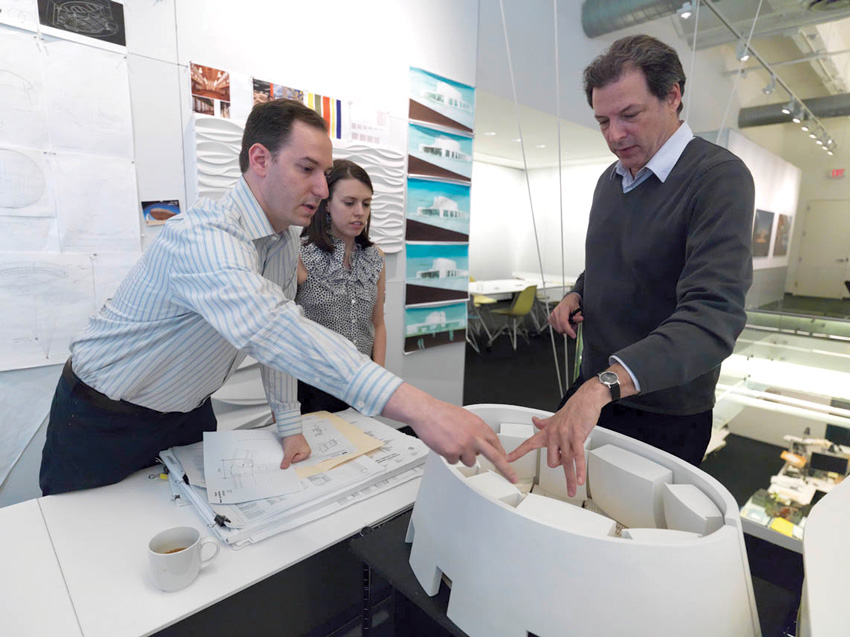
PHOTOGRAPHY: © ANDY RYAN
Ennead’s Richard Olcott (right) and colleagues discussing the design of a concert hall

PHOTOGRAPHY: COURTESY MARMOL RADZINER
Marmol Radziner’s fabrication shop in El Segundo, California
Without more aggressive efforts to remedy the inequalities in the profession, large firms will increasingly seem out of step. But all of these challenges—a reliance on construction documents for profits, hourly or lump-sum payments, diversity, even firm size as a determining factor for jobs—are all holdovers from the last century. Stasiowski, who is currently working on a book about the state of the profession in the year 2030, predicts that the large-firm business model “will be subject to all kinds of gyrations in the next 10 to 15 years,” but that new ways forward will be forged. “The younger professionals—who grew up in the digital age and are now burdened by this antique, time-card mentality—are going to be the ones who break out of the larger firms and create new ways to do business.”
Martin C. Pedersen runs the architecture and design website Common Edge (commonedge.org). He lives in New Orleans.
ENNEAD (FORMERLY POLSHEK PARTNERSHIP)
New York
Founded in 1963
190 Employees
GOULD EVANS
Kansas City, Missouri + Other Locations
Founded in 1974
153 Employees
KPF
New York + Other Locations
Founded in 1976
558 Employees
MARMOL RADZINER
Los Angeles
Founded in 1989
220 Employees
MITHUN
Seattle and San Francisco
Founded in 1949
159 Employees
PAGE
Washington, D.C. + Other Locations
Founded in 1898
479 Employees
Extra-Large Firms
Three mega-offices, with their distinct histories, reveal strategies for addressing problems looming for the profession.
By Laura Raskin
Think of the conditions in the world today: aging infrastructure and an urgent need for housing across the globe; a warming planet and exponential natural disasters that leave communities to pick up the pieces; a construction industry that, according to a 2017 McKinsey Global Institute report, has evolved at a glacial pace, despite being one of the largest economic sectors. Rapidly changing technology. Terrorism. And, overall, a globalizing economy. Because of their size and reach, extra-large architecture firms—for the sake of this investigation, let’s say those with 1,000 employees or more—are perhaps best equipped to tackle these daunting challenges. As Lance K. Josal, CEO of CallisonRTKL, wrote for a Design Intelligence blog post in 2017, “Who better to deal with these topics than a professional trained in life-safety, resiliency, and design on a global scale?”

PHOTOGRAPHY: COURTESY GENSLER
Gensler’s New York offices, with internal stairs for multiple levels
These themes were repeated in recent interviews with CEOs at three of the largest U.S. firms: Perkins + Will (P+W) continues to acquire other firms (three in the last 12 months) to provide a one-stop design shop, and the company runs its own rigorous research arm; Gensler, founded in 1965 and credited with advancing the practice of architecturally oriented interior design, is building bigger and bigger, having completed the Shanghai Tower in 2017, China’s tallest building; and 100-year-old employee-owned HDR continues to saturate such seemingly disparate markets as workplace and health care, while getting design recognition along the way.
To continue to be successful, practitioners at these firms say they must embrace diversity in their workforce as well as their work product; act locally, regionally, and globally; and offer “full service,” from graphic design to urban planning. There is pressure to complete projects in a range of scales and markets with speed and agility, and at a low cost—while simultaneously producing quality design that can compete with a boutique firm’s specialized aesthetic.

PHOTOGRAPHY: COURTESY PERKINS + WILL, © GAFFER PHOTOGRAPHY
Perkins + Will’s Minneapolis office in the IDS Center
Growth and Globalization
“Size is never something we think about,” says Phil Harrison, CEO of P+W. “It’s a result, not a strategic goal.” Instead, a desire to work for “best-in-class clients” in a globally integrated marketplace will continue to motivate the firm’s expansion plans. The firm’s test for adding an office or acquiring another firm is: Can they serve their clients better by being more geographically diversified or offering more services? If they are expanding, is there a good pool of talent in that area? Typically, the firm wants its offices in metropolitan areas with more than 5 million people.
In January, P+W acquired the 170-person Copenhagen-based firm Schmidt Hammer Lassen Architects—a move inspired by a post-Brexit world and the need to have mainland European offices in addition to its London one, as well as the desire to tap into Scandinavia’s design talent. But, driven by a different strategy, P+W merged last October with Denver’s Sink Combs Dethlefs in order to expand its wellness, sports, and recreation practice—a now “booming” market, according to a 2017 report, as the wellness industry is “reaching beyond its (narrowing) association with wealthy elites.”
HDR CEO Doug Wignall has seen his firm’s growth skyrocket abroad in the last decade. About six years ago, HDR decided to diversify outside the U.S., using a similar formula to P+W’s: a new office should be located in a country with robust GDP growth, a strong banking system, and a history of ethical means of doing business. “The world then becomes very small,” says Wignall. About 60 percent of HDR’s growth has been achieved through acquisition. The firm has eight offices in Germany alone, six of them acquired by buying TMK Architekten in 2013. HDR has also established outposts in Australia and Canada. Six years ago, 3 percent of HDR staff and 5 percent of the work was overseas; now that ratio is 35 percent and 40 percent.
But when is big big enough—or too big? “There is a point where you move into as many markets as deeply as you can. We’re not there yet,” says Wignall. “We are starting to compete in building types that aren’t institutionally based, including retail, corporate, hospitality, aviation, etcetera. But to do that, we’ll have to acquire that expertise.”
Gensler, the global architecture and planning firm with 45 offices in 14 countries, was founded by M. Arthur Gensler, Jr. “by happenstance . . . with no grand plan,” he says, recalling the time Alcoa asked him, then 28 years old, to do its interiors while he was at Wurster Bernardi Emmons. (At 83, he still goes into the San Francisco office every day.) Gensler has held the title of largest U.S. architecture firm for six years, with more than $1.19 billion in revenue in 2017. The practice works in roughly 30 sectors, from aviation to brand design. It will not venture into design-build or acquisitions, however, says Gensler. “We’re a private company, and we don’t buy firms.” Firm co-CEO Diane Hoskins echoes P+W’s Harrison when she says, “We’ve never had a goal of being a certain size.” As the world continues to urbanize, “clients and communities want us to help them think about their future.” Gensler has started an innovation-and-research consultancy, and its statisticians, data analysts, and other non-architect scholars are leading its focus, says Hoskins, on everything from the future of education to how fuel cells can be deployed in buildings as a sustainability measure. The self-funded program is not paid for by clients, except in certain instances.
Agility Matters
All three CEOs say that, aside from wanting to penetrate new markets, the growth of their firms is a result of a desire to be local and embedded in the communities and cultures where their clients are. Says P+W’s Harrison, “We are striving to be the largest small firm possible. We want to have a culture, a decision-making structure, and a leadership distribution that feels like a small firm, so you don’t have to go up a big, bureaucratic chain of command and can take action right away.” As he puts it, if you go to a meeting with 200 people, it’s not a meeting. Technological tools and social networks within the firm provide the research on certain subjects, such as health care or resiliency, which is dispersed to new projects that come up. For each design endeavor, a custom team is gathered.
Collecting Data
Like Gensler, HDR is investing heavily in predictive analysis. “We’re finally getting to the point where there’s enough data available that you can organize and manipulate it and make predictions,” says Wignall. “We’re hearing all about that now with Facebook. You can do the same thing with building data.” With the erosion of the classic design and construction-document model, and the commoditization of the “back end” of construction, he believes HDR should focus on what architects do best–design–and then augment that with technology. Through parametric modeling, HDR’s data analysts attempt to predict how a building’s design will affect their client’s outcomes, operationally and financially. “It’s a really compelling story for the owner, and it’s making our design process better and better.” According to Wignall, the resulting design is enhanced because architects can spend more time on aesthetics. The fees for this service are included as a “base offering,” he adds, with exceptions for extensive analysis.
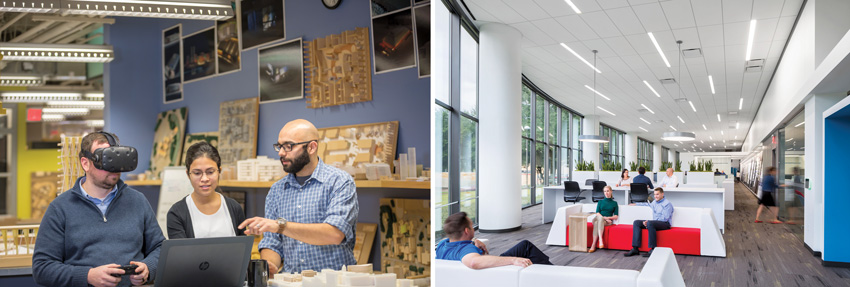
PHOTOGRAPHY: DAN SCHWALM/HDR
HDR’S Princeton office with VR equipment (left) and the firm’s Dallas office (right)
Diversity, Staff Equity, and #MeToo
When P+W turned 75 in 2010, one of its 25-year goals was to achieve global diversity, which the firm defined in terms of gender, race, ethnicity, geography, and skill sets. “We thought, We’re going to move the needle slowly,” says Harrison, “but in the last three years, we’ve realized it’s an immediate, urgent goal.” P+W has also been implementing procedures to ensure salary equity and is planning to publish the results soon.
Wignall reports that employee-owned HDR’s most recent five-year plan is focused on staff development rather than on finance goals. He’s aware that young designers, who have greater technological skills, have less patience for the plateaus of traditional career development and have far less allegiance to any single employer. The business, tech, and hospitality worlds thrive on workers who see themselves as free agents and who can practice their craft from anywhere, including their apartments. To counter this, Wignall says HDR allows staff to do independent research, and underwrites employees’ involvement in various professional organizations.
At Gensler, the staff is 54 percent women, and the firm has always had women in leadership roles, says Hoskins. (Given Gensler’s history and practice in interior design—a field with 66 percent women, according to a 2017 study by Interior Design magazine—that statistic isn’t so surprising.) Hoskins, who is African American, says that diversity at Gensler is almost a matter of course.
In the male-dominated worlds of architecture and construction, and an atmosphere that has historically glorified late nights in studios and hero-worship of its mostly white, male auteurs, it is not surprising that #MeToo has begun to crack open the issue of sexual harassment in the profession. Manhattan-based employment attorney Mark Ottinger says that two of the strongest ways in which firms can protect staff and send a no-tolerance message is by doing away with confidentiality agreements in harassment settlements and ending arbitration agreements, which many employees often sign when hired without realizing it. These require disputes with the firm to take place behind closed doors. Neither P+W nor HDR make their employees sign either kind of agreement. Gensler’s Hoskins says only, “Every issue, person, and situation is unique, and everyone deserves to be treated fairly. That’s the bottom-line view—fairness.”

PHOTOGRAPHY: COURTESY GENSLER
Gensler’s Los Angeles office
Costs and Value
Firms are seeing rapid change in almost every aspect of practice—except in fees, according to P+W’s Harrison. “Fees change slowly, and the basic methodologies that we use to come up with fees change slowly,” he says. “A lot is still based on construction cost, square footage, time, and materials of actual effort.”
From Wignall’s perspective, fee structures are changing more quickly. Instead of project fees being based on a percentage of construction costs, he says that the majority of the firm’s work is billed on an alternative delivery model—a term for projects that don’t fall under the traditional design-bid-build rubric, including integrated project delivery (IPD), public-private partnerships (P3), and multiple variations on design-build work.
Gensler’s Hoskins agrees, adding that the firm typically follows a value-based compensation model, where a base fee is charged, and compensation is added as design teams hit certain building-performance targets.
Architects as Thought Leaders
If architects are going take the lead in addressing the challenges of our time—and are going to avoid being marginalized by Silicon Valley start-ups that are pushing into the design and construction sector—“we have to get out of the office and see what is happening in our cities,” says Hoskins. She notes that climate change and the fact that buildings contribute such a big percentage of the CO2 on the planet need to be addressed: “At Gensler, we have a strategy to ensure every project is moving towards a carbon-neutral model.” Architects must also help communities build contextual, smart cities—one reason why Hoskins sees Gensler’s 45 individual offices as so important. In Los Angeles, for example, where homelessness rose 23 percent from 2016 to 2017, the local office designed a prefab permanent supportive-housing prototype that it hopes to help implement.
Harrison says that it’s time for architecture to be aspirational and broaden its mission in an increasingly urbanized world. Designers need to create change—to have an impact on “tertiary” sectors: health, quality of life, education, social equity, mobility. He adds that architects need to assume a much broader role as designers, taking a page from their polymath Renaissance forebears. If these firms continue on the paths they are pursuing now, there is hope for a new golden age.
Laura Raskin, a former editor at RECORD based in Brooklyn, New York, writes about architecture.
GENSLER
San Francisco + Other Locations
Founded in 1965
5,500+ Employees
HDR
Omaha, Nebraska + Other Locations
Founded in 1917
9,600+ Employees
PERKINS + WILL
Chicago + Other Locations
Founded in 1935
2,200 Employees
Show Me the Money
Architects must change the profession’s value proposition and find new ways to do business.
By Phil Bernstein
A recent headline in Britain’s tabloid Express read, “Construction jobs BOOM: Bricklayers and plasterers earn MORE than architects.” It seems that skilled construction workers in the UK are at the front of the pay line, with architects bringing up the rear. Ouch. But architects reading this headline on either side of the Atlantic are hardly surprised.

IMAGE: © MADMAXER/GETTY IMAGES
There’s an oft-repeated trope in our profession that we’re underappreciated, losing ground to specialists, and under the thumb of contractors. Most architects have their own version of these complaints, but, unfortunately, they reflect the reality of the essential value proposition of architecture as a profession. Despite the relative strength of the current economy, architects are still paid far less than comparable professionals of equal education and import, and we create value through outmoded delivery systems where the client’s first—and often most important—priority is getting the lowest fee from the architect. When your price is driving selection, you’re a commodity.
Let’s examine the economic dynamics of this syndrome, and then I would like to challenge the current methods of value creation and propose a new business model for architects.
Why the Value of Architectural Services Is Depressed
First, some economic basics: according to AIA statistics, American architects are responsible for designing about $600 billion worth of buildings each year, for which they are paid approximately $29 billion in fees, or about 4.8 percent of construction value. Those fees are largely paid as a commodity, mostly as lump sums or versions of a fixed fee (like percentage of construction). But real value is rarely reflected when compensation is a commodity, and that is hurting the overall economics of the profession.
Other professions have much better value propositions, and that shows up in their paychecks. There are about 110,00 licensed architects in the U.S. and about 126,000 billable positions in U.S. firms. Compared to the 950,000 practicing physicians and 1.33 million lawyers, we’re a pretty rare resource. Nonetheless, the salaries of architects—as a proxy for how well we convert our value in the marketplace of building—are depressed, and that’s depressing.
At Yale, where I teach, three of the professional schools accredited for licensure (Law, Architecture, and Medicine) make for an interesting comparison of starting and early-career salaries for graduates, who presumably are in high demand and able to command paychecks at the high end of the spectrum:

The architecture profession today is far leaner and meaner than its pre-crisis state in 2009, likely due to new technology. Net revenues of American firms have largely recovered from the dip, having returned to their 2008 peak by 2015. But firm staffing has decreased by 18 percent, from 128,000 billable positions in 2008 to just 126,000 in late 2016, meaning 23,000 fewer in staff are doing roughly the same amount of work. Salaries are showing modest rises but fee percentages probably lag pre-crisis levels, and since employees haven’t seen 18 percent increases in their paychecks, the productivity gain may be even higher. And while there are no well-understood measures of architectural productivity, there is a strong correlation between this productivity jump and adoption of advanced technologies like BIM in our discipline. But efficiency merely drives prices down further in a market where time spent isn’t related to value delivered.
Are Architects Selling Time or Results?
Commoditized fee structures, salary pressure, and low profit margins are all symptoms of a larger disease: the actual value that architects create is not realized for them financially. Buildings are central to civilization itself, and absolutely necessary not just for survival but progress. As insurance companies remind us relentlessly, designing things is risky business, but the business risk of practice (running out of money) is not correlated to liability risk (getting sued), unlike the way it is in almost every other market where assuming higher risk means a higher reward. The economic models for designing and building—how architects and builders are selected and contracted—are almost exclusively driven by getting the lowest price, irrespective of the desired result. Enormous waste (as much as 35 percent of construction costs), ineffectiveness (where around 30 percent of all projects miss budgets and schedules), and environmentally irresponsible building (resulting in 40 to 50 percent of the carbon contributing to climate change) are the outcomes. Clearly, there is lots of room for improvement. Designing and building remain risky, questionably profitable, unpredictable, and often just not very much fun.
Once upon a time, contracts in our business were gentlemen’s agreements (and they were, unfortunately, all gentlemen). But, since then, various experiments in project-delivery models—construction management, design-build, “early contractor involvement,” design assist—have each attempted to make the industry more effective. Whether “bring the contractor on early!” (construction management), or “create one line of responsibility” (design-build), or “let the builders do the working drawings” (design assist), each of these attempted to improve the ends without a careful reexamination of the means. None of these techniques, despite episodic success, has improved the productivity, profit margins, results, or even the pleasure of working in the building industry itself.
But focusing exclusively on productivity and cost/schedule conformance is to miss the real opportunity for change, like measuring the success of surgery not by whether the patient is cured but by how fast the procedure was completed. There is another way: shifting the value propositions of practice from selling time to creating results for clients. Compensation models could be based on delivering outcomes of the building process itself, including the performance of the finished building. This isn’t just magical thinking—rapidly evolving technologies that combine the computational power of the cloud, the representational potency of digital models, and the analytic capabilities of simulation software are already allowing designers to predict aspects of building more accurately—cost estimating with more quantitative precision, energy consumption based on use, even embodied energy and carbon. It is just a matter of time before these technologies expand the predictive reach of the architect into occupant behavior, building life cycle performance, even usage outcomes like employee satisfaction or staffing efficiencies.
Using Digital Tools to Drive Results and Innovate Practice
The implications of this strategy are far more profound than just new contracts and fee formulas or fancy digital simulation tools. The predictive power of new digital tools can amplify our abilities as designers to solve complex “wicked problems,” as theorist Horst Rittel puts it, and create new, important, and valuable solutions for clients willing to pay for them. But practice models, design methods, and our willingness to take responsibility for the results of our work, will need radical reform.
The economic models for designing and building are almost exclusively driven by getting the lowest price, irrespective of the desired result.
We could start with the immediate challenges of cost and schedule conformity, working in concert with our builder collaborators to assure clients that these basic objectives of design and construction can be accomplished—and we should be rewarded when they are (and punished when they are not). Establishing credibility from there, we could move on to building-performance objectives like energy usage, carbon emissions, even maintenance-cost optimization. Ultimately, an outcome-based delivery system could connect the purpose of a building—offices to boost the effectiveness of workers, schools to teach better, hospitals that promote faster healing—with the architect’s ability to realize those goals. These changes in the business model can’t be implemented by architects unilaterally, but clients would certainly welcome any strategy where the architect, with skin in the game, is truly invested in project-based outcomes that are both in the client’s and the architect’s interest.
Examples of result-based fees have been gaining momentum in construction: architects paid to provide subcontractors with digital data under design-bid-build; shared conditions based on selected outcomes in CM at Risk contracts; integrated teams under design-build; outcome-based profit objective paid under Integrated Project Delivery (IPD). Architects empowered by predictive and simulative tools (and, soon enough, bolstered by machine learning and big data) can operate with more powerful agency to create greater value for clients.
And here’s where today’s innovation culture can meet the challenges of outcome-based practice; technology might be necessary, but it’s not sufficient to create ideas of new value, and technology’s potential will go unrealized without equal inventiveness in new business models, practice approaches, and willingness to experiment with definitions of architectural services. In the past several years, I have observed a dramatic shift in the interests of my architecture students, who are increasingly dissatisfied with the standard platforms, obligations, and rewards of traditional practice; they have lost their enthusiasm for establishment firms. They’re taking courses outside the architecture school at the business school, some even earning MBAs to go with their M.Arch.’s. They are studying and generating innovative business models, creating start-ups, joining hackathons, and seeking jobs with firms led by architects who are also entrepreneurs, researchers, builders, and developers. This is good news for the profession: a generation of fresh talent demanding new ways of practice, moving ahead with both youthful enthusiasm and a blissful ignorance of our inglorious past.
The architect and mathematician Christopher Alexander once suggested that architectural design was the obligation to create “an intangible form in an indeterminate context.” This can certainly be true of the serious, ineffable qualities of good design. But in our modern age, the practical context is increasingly determinate, and outcome-based design practice—enabled by new attitudes, business models, and technology—will empower us to deliver the real value of both.
Phil Bernstein is Associate Dean and Senior Lecturer at the Yale School of Architecture. This essay is based on his book Architecture Design Data: Practice Competency in the Era of Computation, which will be published by Birkhauser in August.
Excessive Resolution
Designers meet the second coming of artificial intelligence.
By Mario Carpo
Designers have been using computer-based tools for design and fabrication for almost one generation. In the course of the last 30 years we have learned that computers can help us draw and build new forms of unprecedented complexity, and we have also discovered that, using CAD-CAM technologies, we can mass-produce variations at no extra cost: that is already history—the history of the first digital turn in architecture. Today, however, more and more powerful computational tools can do way more than that. Computers, oddly, seem now capable of solving some design problems on their own—sometimes problems we could not solve in any other way. Twenty years ago we thought computers were machines for making things; today we find out they are even more indispensable as machines for thinking. That’s one reason why many, including many design professionals, are now so excited about Artificial Intelligence (AI). The term itself, however, is far from new: it was already popular in the 1950s and ’60s, when computer scientists thought that Artificial Intelligence should imitate the logic of the human mind—that computers should “think” in the same way we do. Today, to the contrary, it is increasingly evident that computers can solve some hitherto impervious categories of problems precisely because they follow their own, quite special, logic: a logic that is different from ours. And already it appears that this new, post-human (or, simply, nonhuman) logic vastly outsmarts ours in many cases.

IMAGE: COURTESY GILLES RETSIN ARCHITECTURE
Linear hexagonal strands define a series of thick volumeteric strata in Hextrata, designed by Gilles Retsin Architecture for a Vienna art museum extension.
The main difference between the way we think and the way computers solve problems is that our own brain was never hard-wired for big data. When we have to deal with too many facts and figures, we must inevitably drop some—or compress them into shorter notations we can more easily work with. Most classical science was a means to that end. Geometry and mathematics—calculus in particular—are stupendous data-compression technologies. They allow us to forget too many details we could never remember anyway, so we can focus on the essentials. Sorting is another trick of our trade. As we could never find one name in a random list of 1 million, we invest a lot of work in sorting that list before we use it: if the names are ordered alphabetically, for example, as in a telephone directory, we can aim directly at the name we are looking for without having to read all the names in the list, which would take forever. Yet that’s exactly what computers do: since they can scan any huge sequence of letters and numbers in almost no time, they do not need to keep anything sorted in any particular order. Take alphabetic sorting as a metaphor for the way we think in general: we put things in certain places so we know where they are when we need them; we also sort things and ideas to make some sense of the world. But computers need none of that: unlike us, they can search without sorting. Computers are not in the business of investigating the meaning of life either.

IMAGES: COURTESY DANIEL KOEHLER, BARTLETT UCL (LEFT); MANUEL JIMÉNEZ GARCIA, BARTLETT UCL (RIGHT)
WanderYards, designed by Daniel Koehler and Bartlett UCL students (left) shows how shifts of combinatorial granularity enable diversity through repetition of simple space samples. VoxelChair v1.0 (right), designed by Manuel Jiménez Garcia and Gilles Retsin of Bartlett UCL Design Computation Lab, is a prototype chair using new design software for robotic 3-D printing.
Just as we could not easily deal with a random list of a million names when we look for one in particular, we could not easily work with a random heap of 1 million different bricks when we need them to build a house. In that case too, our natural aversion to big data (or to data too big to manage) drives us to some drastic simplifications. First, we standardize the bricks, so we can assume they are all the same. Then we lay them in regular rows, and we arrange all rows within simple geometric figures—most of the time, rectangles or circles drawn in plans, elevations, and sections. Thus we can forget about the physical shape and material properties of each individual brick, and we can design entire buildings by composing simpler and cleaner outlines of bigger and supposedly uniform surfaces and volumes. An individual craftsman with no blueprint to follow and no accounts to render could deal with each brick (or stone or wooden beam) on the fly and on the whim of the moment, following his talent, intuition, or inspiration—that’s the way many premodern structures were built. But no modern engineer or contractor would dream of notating each brick one by one, since that would take forever, and the construction documents would be as big as the Encyclopaedia Britannica in print. Yet, once again, this is what computers do. Today, we can notate, calculate, and fabricate each individual brick or block of a building—one by one, to the most minute particle. If the particles are small, they can be 3-D printed on-site. If they are bigger, they can be assembled by robotic arms. That procedure is exactly the same, and takes the same time, regardless of the regularity of the components, their number, size, and layout. Computation at that scale today already costs very little—and it will cost less and less.
Let’s leave to machines what we are not good at doing and keep for us what machines cannot do, which is plenty.
The advantages of the process are evident. Micro-designing each minute particle of a building to the smallest scale available can save plenty of building material, energy, labor, and money, and can deliver buildings that are better fit to specs. Not surprisingly, buildings designed and built that way may also look somewhat unusual. And rightly so, as the astounding degree of resolution they show is the outward and visible form of an inner, invisible logic at play that is no longer the logic of our mind. Perhaps human workers could still work that way—given unlimited time and money. But no human mind could think that way, because no human mind could take in, and take on, that much information. Each to its trade: let’s leave to machines what we are not good at doing and keep for us what machines cannot do, which is plenty.
Machines search—big data is for them. We sort: compressing data (losing or disregarding some in the process) is for us. With comparison, selection, formalization, generalization, and abstraction come choice, meaning, value, and ideology, but also argument and dialogue. Regardless of any metaphysical implications, no machine-learning system can optimize all parameters of a design process at the same time; that choice is still the designer’s. Fears of the competition coming from Artificial Intelligence today may be as misleading as the fear of the competition coming from industrial mass-production was 100 years ago. But, just as coping with the mechanical way of making was the challenge of industrial design in the 20th century, coping with the computer’s way of thinking is going to be the challenge of postindustrial design in the 21st century, because today’s thinking machines defy and contradict the organic logic of the human mind, just as the mechanical machines of the industrial revolution defied and contradicted the organic logic of the human body.
Mario Carpo is the author of The Second Digital Turn: Design Beyond Intelligence and other books. He is the Reyner Banham professor of architectural history and theory at the Bartlett, University College London.
Thinking in Approximations
A structural engineer offers a perspective.
By Robert Silman
The use of computers in analyzing building structures is undeniably a great step forward in our profession. When I trained as a structural engineer in the 1950s, computers were a brand-new wonder, and there were no packaged programs available. If you wanted to use a computer, you had to write the program yourself.

PHOTOGRAPHY: COURTESY SILMAN
Silman completed the renovations of Frank Lloyd Wright’s Falling-water (1937) in Bear Run, PA, in 2002. The process required the firm to shore up the main-floor cantilever as well as the waterfall’s rocky ledge.
Our firm, Silman, founded in 1966, was one of the first to write its own structural-analysis and design programs. In 1970, we took our successful composite-steel-beam design program to the New York City Department of Buildings and asked them how we should file calculations. Fortunately, they realized that this was the wave of the future and suggested that we develop prototype calculations by hand in the conventional way and then submit parallel results performed by the computer, illustrating that the solutions were the same. To do so, we rented an IBM 1130 with 8k capacity, which was fed by decks of punch cards grinding away for many minutes on fairly simple problems. This became standard protocol for the Department of Buildings, and the first nine programs filed were from our office.
So I am a great advocate of the use of computers for structural analysis and design, and I always have been. But there are drawbacks. When I was studying structural engineering, I used a slide rule, a wonderful apparatus and now an archaeological artifact. Slide rules help to multiply and divide, provide exponential functions, do logarithms and trigonometry. But the slide rule does not tell you where to place the decimal point. Is the answer 10.00 or 100.00 or 1,000.00?
So most of us, before we even started to fiddle with the slider and the cursor window, estimated the answer in advance. We learned to think in approximations. I can remember designing flat-plate concrete buildings with completely irregular column layouts. We used Hardy Cross’s method of moment distribution and generated pages of incredible calculations for different column configurations. The process become repetitive, and we could guess the required reinforcing pretty accurately before putting pen to paper.
This arcane process gave us a “feel” for the buildings that we were designing. They were not some abstract product of machine technology but were rather tactile creations of our very selves. We had used our intuition, which became sharper with experience. There was no way that a large-scale mistake would find its way into the work–we would notice it as a glaring intruder on our orderly process.
In my present role, I review drawings produced by the engineering staff. When I spot an error, the young engineer inevitably will say, “How did you see that so quickly?” I shrug and reply that it was how I was trained, to think about the approximate answer before figuring out the answers. When skipping that intuitive step, one can be easily seduced by computer results that look so neat and orderly.
I am not a Luddite: Our early design methods had enormous shortcomings. Perhaps two of the most grievous were the inability to model the building in three dimensions, as a whole entity, as well as the difficulty in computing building movements. Even structuralanalysis problems of modest indeterminacy were often impossible to solve. Anyone could write the compatibility equations, but as the unknowns grew beyond four or five, finding solutions loomed as a lifetime chore.
So we developed neat techniques called approximate methods. Large mathematical matrices of the compatibility equations could be partitioned and manipulated with all sorts of tricks. Indeed, some very complicated buildings were analyzed using tricks, and they have behaved beautifully over their lifespans, much to the credit of their designers.
For sure, the complicated geometries and configurations of buildings today could never have been analyzed with any degree of confidence using some of these approximate techniques. Computer analysis provides a higher level of mathematical certainty about the behavior of a structure—advantageous in new construction as well as in the renovation of historic buildings. One example is Fallingwater, which we helped renovate in 2002. To fix the sagging cantilevers, we needed to determine the stresses in the main cantilever girders that support the house. We knew accurately the building geometry and the reinforcing in the girders, as well as the actual deflections that had occurred over the first 60 years. By performing a three-dimensional analysis, and accounting for the participation of the slabs in two-way action by computer, we were able to manipulate various stiffness factors until the calculated deflections of every cantilever matched the actual measured deflections. With this information we could then design the repair, placing the right amount of post-tensioning where needed. Approximate methods would not have provided the precise answer required.
So how do we train ourselves to get the utmost out of computer analysis without losing an intuitive sense of how a building should behave and what its constituent members should look like? And, as our buildings become more complicated, is it really possible to develop that sort of grasp of their structural elements? We should at least start with some training in approximate analysis of simple structures. Like my professor in my first graduate course in indeterminate structures, instructors should demand that, for the first four weeks of the class, students not be allowed to use any mechanical aids–no calculator, no slide rule, and certainly no computer. Professors should encourage them to sketch the shear and moment diagrams and the shape of the deflected structure; they should thus be able to determine the critical points and quantify them within 15 percent accuracy.
It seems to me that we cannot depend wholly on the answers high technology can give us. Rather we must develop a feel for structures by using some of the educational techniques of the past—fostering the ability to see the whole, which technology supports but cannot replace.
Robert Silman, president emeritus of Silman, the structural engineering firm, is on the faculty of the Graduate School of Design at Harvard University.
The Disruptors
Technologically savvy firms lead the profession and embrace change.
By Fred A. Bernstein
As a partner at Ennead, the Manhattan architecture firm, Tomas Rossant has helped many colleges and universities develop master plans. He generally begins by spending a day observing people moving around campus, but what he finds, he admits, is “situational and subjective; it’s affected by whether it’s raining and whether it’s homecoming weekend, and so on.” So Ennead’s applied-computing department has developed an app to track where students and faculty go and when—potentially a better way to document campus activity. Rossant can’t talk about the details yet, but he has met with venture capitalists about turning the app into a product that could be made available to users other than Ennead and its clients.

PHOTOGRAPHY: © KIERANTIMBERLAKE
KieranTimberlake staff using projection mapping
“Do we want to give this away, or do we want to make money off it?” Rossant asks, suggesting that Ennead may take an “if-you-can’t-beat-’em-join-’em” attitude to software development, which could be more lucrative than just practicing architecture. If so, Ennead will probably create a discrete corporation to develop and sell its campus-planning software. In choosing that route, it would be following a trail blazed by Philadelphia-based KieranTimberlake (which offers several apps through its KT Innovations affiliate, owned by the firm’s founding partners) and the Seattle-head-quartered NBBJ (which formed a separate company to market a virtual-reality tool)—and, much earlier, by Frank Gehry (whose firm spun off Gehry Technologies with its Digital Project software, in 2002).
Of course, not every architecture firm in the future will spawn a separate software company, but every architecture firm will have to respond to technological changes that are rocking the profession. Over the past two decades, new tools have transformed ateliers into veritable computer labs. But soon the continuing digital revolution may have even more dramatic consequences. “There are hundreds of kinds of technology that will impact the practice of architecture,” says Christian Derix, the director of Superspace, the computational-design group of Woods Bagot, a global firm with nearly 1,000 employees in 14 offices. “Architecture is facing an existential crisis,” agrees his colleague Shane Burger, a principal and director of technical innovation. He believes architecture firms that also do software will eventually turn into software firms that also do architecture. “I don’t see it as a threat to the profession,” says Burger. “I see it as a threat to the business model. It’s just a question of what the identity of the architecture firm will be 10 years from now.”
Other fields, from education to communications, have been radically altered by technology. “Architecture is ripe for disruption,” says Steve McConnell, the managing partner of NBBJ. “Efficiencies aren’t going to just be born out of a traditional architecture practice, but through application of high-tech tools.” Instead of expecting clients to rely solely on our expertise, he says, “now we have the ability to use algorithms to prove the value of our work.”
One technology that could be particularly disruptive to the profession is machine learning. An approach to achieve artificial intelligence, machine learning is a way for computers to discern patterns in vast quantities of data. But several experts say it could also be used to generate designs. According to Kat Park, the firm-wide emerging-technology leader for Skidmore, Owings & Merrill (SOM), machine learning is different from parametric modeling, in which you “wrote a script to produce a design outcome. That’s the old-school way of using computers.” With machine learning, however, “there is no script. The computer is a black box.”
Is that one way that machines will replace human architects? Derix says that a computer with enough data on existing buildings—say, hospitals—can use algorithms to create configurations for a new one. “That’s where machine learning becomes dangerous to the profession,” he says. “Design will be a kind of data search.” But that prospect also offers promise, says Park. “If we took all of our firm’s past data and fed them into a machine, that would encode the expertise of SOM.”
A self-described optimist, Park says that machine learning may solve problems humans don’t have the brain power to solve—and do so almost instantaneously (see “Excessive Resolution,” page 135). That means that architects can get answers to complex questions early on. “We’ve been talking for so long about making performance analysis available at the concept stage, when it has the most impact,” she says, “but until now we haven’t had the tools.”

PHOTOGRAPHY: VENILDA ROSADO
Sheila Kennedy (far right) in Peru with High Altitude Urbanism design-team members
Woods Bagot’s Burger says the future will belong to architects “who are so used to working with these new tools that they become extensions of their minds.” He calls them “augmented” architects. Architects shouldn’t be scared of the new tools—a pencil is a tool, he notes. But, he says, “the firms that are going to survive are the ones that embrace the role of the augmented designer.” SOM’s Park concurs: “If you don’t know how to work with a robot, or work with an intelligent machine, you will probably be out of work.” (No wonder the new machines are sometimes known as “cobots.”)
For the architecture profession, there are other big challenges on the horizon. In recent years, firms like SHoP have pushed for modular construction, investing in technologies that would facilitate factory fabrication, providing greater control over the finished product. But now Silicon Valley tech companies are jumping into the game. Katerra, a startup with nearly $1 billion in funding from SoftBank, the Japanese conglomerate, is promising to use technology to transform design, the building-product supply chain, and the construction process. Architects have long chided the building industry for old-school ways, “but now it may leapfrog over us,” Rossant predicts. Yet SHoP continues to explore new construction and fabrication methods—most recently through a potential collaboration with a car company, according to partner Chris Sharples, though he declined to provide details.
Another well-financed start-up moving into architects’ territory is WeWork. Best known for providing shared office space to young creatives, the company is now selling design services to its corporate clients and is expanding beyond workplaces. It already employs architects in major cities. Last month, it appointed the Danish wunderkind Bjarke Ingels as its chief architect, upping its design game overnight.
So if architecture’s core functions are losing value, what does the profession have to offer? “Critical design thinking is the one thing that can’t be replaced by an algorithm,” says Rossant. “Right now, Ennead is an architecture firm that gives away strategy free. We’re thinking of becoming more of a strategy firm that gives away architecture free.” Though he makes clear that Ennead will always put architecture first, he would like the firm to emulate McKinsey & Company, the consulting group that charges handsomely to give business advice.
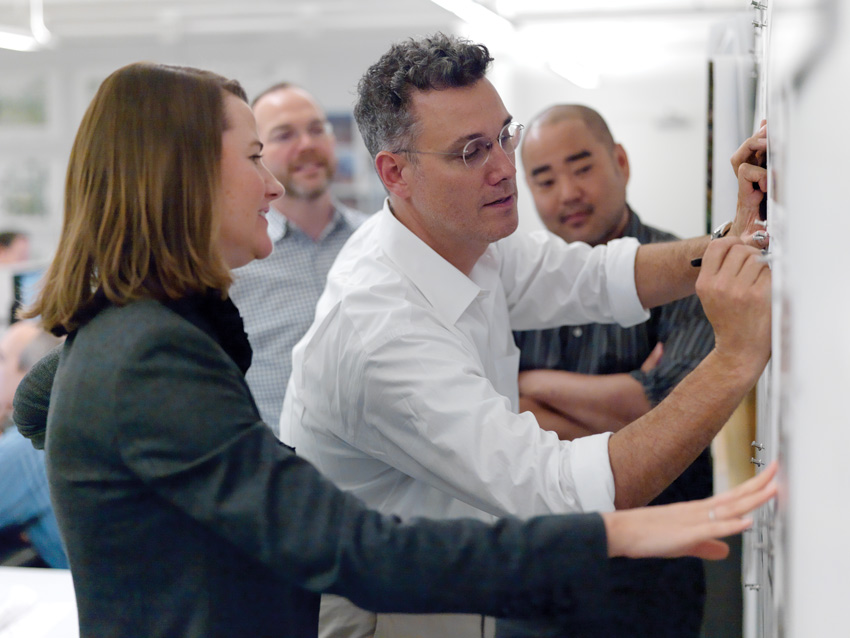
PHOTOGRAPHY: ANDY RYAN
Tomas Rossant (center) and Ennead colleagues
Nader Tehrani, dean of the architecture school at Cooper Union and founder of the Boston-based firm NADAAA (see page 122), sees another way for architects to expand their role: “The architectural voice can become instrumental in the many political and cultural conversations that are affecting the world today, among them climate change, health, education, food, and the state of the city as a place to live, to name just a few.” Kennedy Violich Architects, based in Boston, has been bringing “design thinking” to non-architectural problems since its early days. It worked with a startup company that uses big data to reduce solar-energy costs through peer-to-peer energy sharing in Australia. More recently, in the Peruvian Andes, the firm led a workshop that helped devise a system for Wi-Fi connectivity in high-altitude villages. The goal, says principal Sheila Kennedy, is to “imagine the future while testing ideas on the ground in the present reality.”
One way for firms to embrace the future is to rely on expertise from other fields. NBBJ offers a fellowship, which for the last four years has been held by a neuroscientist, John Medina, who works with the firm’s architects to identify ways buildings can improve health and happiness. Methods include encouraging movement, bringing users into contact with nature, and facilitating serendipitous meetings among colleagues. The office translated Medina’s insights into computer simulations, to predict the number of such interactions likely to occur in each iteration of an office tower designed for the Chinese company Tencent, in Shenzhen.
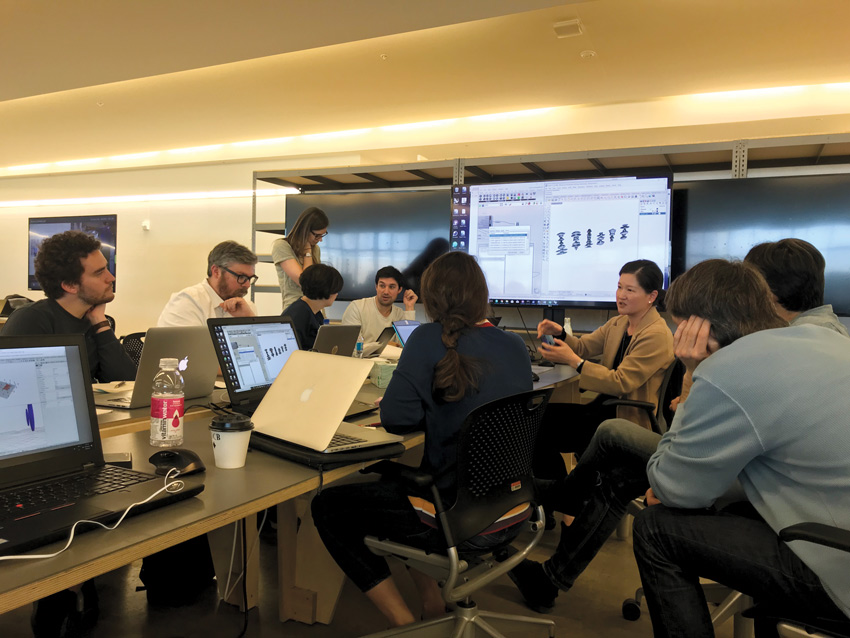
PHOTOGRAPHY: © SEBASTIAN MISIUREK
SOM’s Kat Park (facing, right) sharing insights in a Smartgeometry group
KieranTimberlake, meanwhile, hired architects who also have degrees in fields like sociology, ecology, and computer science. “When I joined the firm in 2008,” says Billie Faircloth, a partner and the company’s tech guru, “my charge was to build up a transdisciplinary practice.” While assigned to actual design projects, KieranTimberlake’s architect hyphenates also form internal research groups. On a recent Friday, the dozen or so members of a group called Near Future Practices met in a conference room in the firm’s Philadelphia office, a former beer-bottling factory, to discuss using machine learning as a way of improving buildings’ energy efficiency. “If we had the data on predicted versus actual energy consumption of a large number of buildings, we could begin to rank which factors actually matter in terms of energy use,” she says. But the amount of data required is, Faircloth cautions, “bigger than any one firm. So we have to ask ourselves, as a profession, do we want to work together to get this data? And,” given privacy concerns, “is it appropriate to do so?” These are the kind of questions that architects’ moving rapidly into evolving technologies, and their clients, will have to address.
Meanwhile, NBBJ has taken another route to getting out in front of technological change. Seeing an opportunity not just to improve practice and engage clients but to create another income stream, NBBJ founded the virtual-reality (VR) firm Visual Vocal, staffed it with non-architects, and funded it with more than $3.5 million in venture capital. Its product, developed after studying how architects at NBBJ collaborate, is a communications tool that allows project stakeholders to annotate VR presentations verbally. Visual Vocal is selling the product to other firms. But that doesn’t trouble McConnell, who is pleased with the cross fertilization. “We’re putting a start-up and a mature business together” in the same office, says McConnell. “That’s how you avoid becoming calcified.”
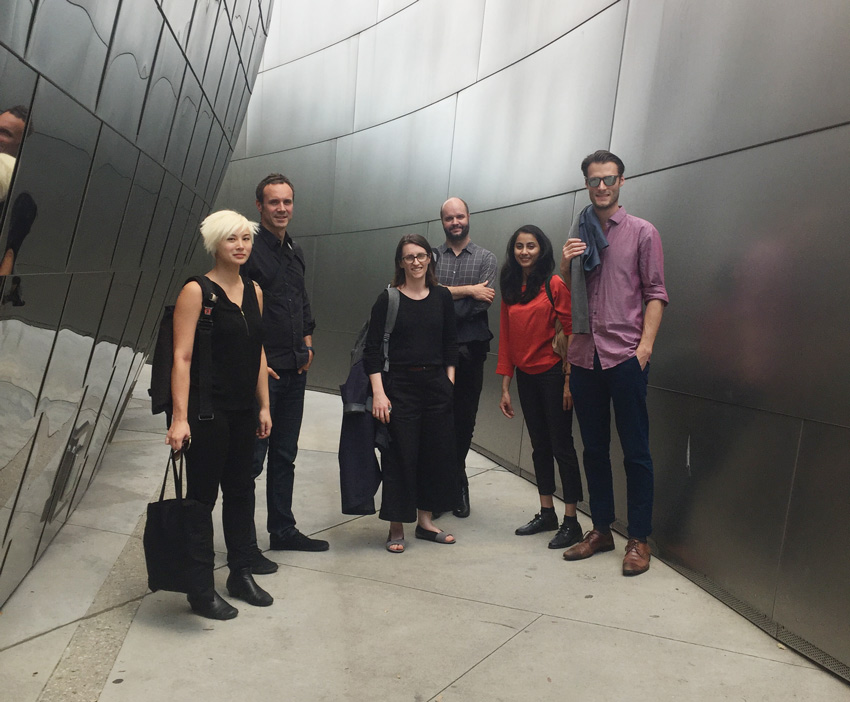
PHOTOGRAPHY: COURTESY CHRISTIAN DERIX
Christian Derix (second from left) in LA with the Woods Bagot team for data-driven design training
KieranTimberlake has also created potentially profit-making products apart from its core architectural practice. On Faircloth’s watch, KT Innovations has released Tally (life-cycle assessment software), Pointelist (a low-cost, high-density sensor network), and, most recently, Roast (an occupant-comfort survey app now in beta testing).
In Toronto in May, at the Smartgeometry conference, a biannual gathering of architecture brainiacs, Faircloth and Christopher Connock, KieranTimberlake’s director of design computation, shared insights with representatives of other research-oriented firms, including Woods Bagot and SOM. Although many of the participants are competitors, “we are all interested in the positive redefinition of what an architect does,” says Burger. Naturally, he says, “I’m not handing out code for software that we’ve developed in our practice. But we’re all here to help each other. We all think it’s beneficial to the world to have a healthy architecture profession.”









.jpg)
































